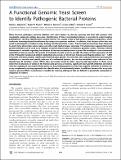| dc.contributor.author | Slagowski, Naomi L | |
| dc.contributor.author | Kramer, Roger W | |
| dc.contributor.author | Morrison, Monica F | |
| dc.contributor.author | LaBaer, Joshua | |
| dc.contributor.author | Lesser, Cammie | |
| dc.date.accessioned | 2011-03-17T13:34:52Z | |
| dc.date.issued | 2008 | |
| dc.identifier.citation | Slagowski, Naomi L., Roger W. Kramer, Monica F. Morrison, Joshua LaBaer, and Cammie F. Lesser. 2008. A functional genomic yeast screen to identify pathogenic bacterial proteins. PLoS Pathogens 4(1): e9. | en_US |
| dc.identifier.issn | 1553-7366 | en_US |
| dc.identifier.uri | http://nrs.harvard.edu/urn-3:HUL.InstRepos:4743184 | |
| dc.description.abstract | Many bacterial pathogens promote infection and cause disease by directly injecting into host cells proteins that manipulate eukaryotic cellular processes. Identification of these translocated proteins is essential to understanding pathogenesis. Yet, their identification remains limited. This, in part, is due to their general sequence uniqueness, which confounds homology-based identification by comparative genomic methods. In addition, their absence often does not result in phenotypes in virulence assays limiting functional genetic screens. Translocated proteins have been observed to confer toxic phenotypes when expressed in the yeast Saccharomyces cerevisiae. This observation suggests that yeast growth inhibition can be used as an indicator of protein translocation in functional genomic screens. However, limited information is available regarding the behavior of non-translocated proteins in yeast. We developed a semi-automated quantitative assay to monitor the growth of hundreds of yeast strains in parallel. We observed that expression of half of the 19 Shigella translocated proteins tested but almost none of the 20 non-translocated Shigella proteins nor ∼1,000 Francisella tularensis proteins significantly inhibited yeast growth. Not only does this study establish that yeast growth inhibition is a sensitive and specific indicator of translocated proteins, but we also identified a new substrate of the Shigella type III secretion system (TTSS), IpaJ, previously missed by other experimental approaches. In those cases where the mechanisms of action of the translocated proteins are known, significant yeast growth inhibition correlated with the targeting of conserved cellular processes. By providing positive rather than negative indication of activity our assay complements existing approaches for identification of translocated proteins. In addition, because this assay only requires genomic DNA it is particularly valuable for studying pathogens that are difficult to genetically manipulate or dangerous to culture. | en_US |
| dc.language.iso | en_US | en_US |
| dc.publisher | Public Library of Science | en_US |
| dc.relation.isversionof | doi:10.1371/journal.ppat.0040009 | en_US |
| dc.relation.hasversion | http://www.ncbi.nlm.nih.gov/pmc/articles/PMC2211553/pdf/ | en_US |
| dash.license | LAA | |
| dc.subject | genetics and genomics | en_US |
| dc.subject | infectious diseases | en_US |
| dc.subject | microbiology | en_US |
| dc.subject | eubacteria | en_US |
| dc.subject | saccharomyces | en_US |
| dc.title | A Functional Genomic Yeast Screen to Identify Pathogenic Bacterial Proteins | en_US |
| dc.type | Journal Article | en_US |
| dc.description.version | Version of Record | en_US |
| dc.relation.journal | PLoS Pathogens | en_US |
| dash.depositing.author | Lesser, Cammie | |
| dc.date.available | 2011-03-17T13:34:52Z | |
| dash.affiliation.other | HMS^Medicine-Massachusetts General Hospital | en_US |
| dc.identifier.doi | 10.1371/journal.ppat.0040009 | * |
| dash.contributor.affiliated | Lesser, Cammie | |


